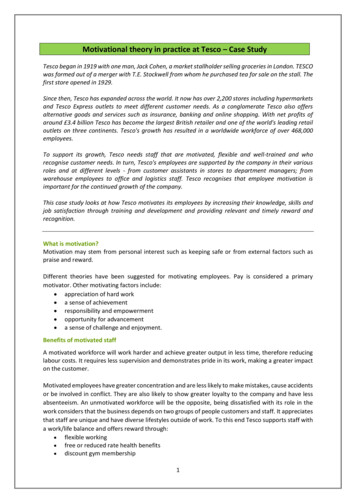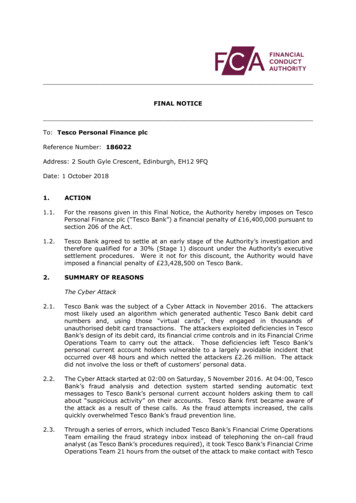
Transcription
FINAL NOTICETo: Tesco Personal Finance plcReference Number: 186022Address: 2 South Gyle Crescent, Edinburgh, EH12 9FQDate: 1 October 20181.ACTION1.1.For the reasons given in this Final Notice, the Authority hereby imposes on TescoPersonal Finance plc (“Tesco Bank”) a financial penalty of 16,400,000 pursuant tosection 206 of the Act.1.2.Tesco Bank agreed to settle at an early stage of the Authority’s investigation andtherefore qualified for a 30% (Stage 1) discount under the Authority’s executivesettlement procedures. Were it not for this discount, the Authority would haveimposed a financial penalty of 23,428,500 on Tesco Bank.2.SUMMARY OF REASONSThe Cyber Attack2.1.Tesco Bank was the subject of a Cyber Attack in November 2016. The attackersmost likely used an algorithm which generated authentic Tesco Bank debit cardnumbers and, using those “virtual cards”, they engaged in thousands ofunauthorised debit card transactions. The attackers exploited deficiencies in TescoBank’s design of its debit card, its financial crime controls and in its Financial CrimeOperations Team to carry out the attack. Those deficiencies left Tesco Bank’spersonal current account holders vulnerable to a largely avoidable incident thatoccurred over 48 hours and which netted the attackers 2.26 million. The attackdid not involve the loss or theft of customers’ personal data.2.2.The Cyber Attack started at 02:00 on Saturday, 5 November 2016. At 04:00, TescoBank’s fraud analysis and detection system started sending automatic textmessages to Tesco Bank’s personal current account holders asking them to callabout “suspicious activity” on their accounts. Tesco Bank first became aware ofthe attack as a result of these calls. As the fraud attempts increased, the callsquickly overwhelmed Tesco Bank’s fraud prevention line.2.3.Through a series of errors, which included Tesco Bank’s Financial Crime OperationsTeam emailing the fraud strategy inbox instead of telephoning the on-call fraudanalyst (as Tesco Bank’s procedures required), it took Tesco Bank’s Financial CrimeOperations Team 21 hours from the outset of the attack to make contact with Tesco
Bank’s Fraud Strategy Team, a specialist group in the Financial Crime OperationsTeam. In the meantime, nothing had been done to stop the attack, the fraudulenttransactions multiplied, calls from customers mounted and the attack continued.2.4.Once the Fraud Strategy Team had been alerted, it determined that the majorityof fraudulent transactions were coming from Brazil using a payment method knownas “PoS 91”. PoS 91 is an industry code which indicated that the attackers weremaking Contactless MSD transactions, transactions which rely on magnetic striperules which carry identifying information about the debit card. PoS 91 is usedpredominately outside of Europe and has no limits in terms of the value or thenumber of transactions. The fact that some of the transactions were successfulsuggested that the attackers may have obtained authentic Tesco Bank debit card“PAN” numbers, the long numbers across the front of debit cards, to make thetransactions.2.5.Having identified PoS 91 as the primary channel and Brazil as the source of mostof the attempted fraudulent transactions, Tesco Bank’s Fraud Strategy Team put arule in place to block those transactions at 01:48 on Sunday, 6 November 2016.2.6.Tesco Bank’s Fraud Strategy Team did not, however, monitor the rule’s operationand discovered a few hours later, that not only was the rule ineffective, but theattempted fraudulent Brazilian transactions were increasing, reaching a peak of80,000 by Monday, 7 November 2016 (with Tesco Bank’s systems blockingapproximately 90%). The rule was ineffective because the Fraud Strategy Teamerroneously used the Euro currency code instead of Brazil’s country code when itcoded the rule designed to block PoS 91 transactions originating in Brazil.2.7.Having discovered their mistake, Tesco Bank’s Fraud Strategy Team redrafted therule, but a residual number of PoS 91 transactions continued to go through TescoBank’s authorisation and fraud detection systems. Unable to solve the problem,the Fraud Strategy Team called external experts to help them. It took Tesco Bankuntil 00:59 on Monday, 7 November 2016 for the external experts to uncover theproblem. The residual PoS 91 transactions were attributable to a coding error whichTesco Bank’s Financial Crime Operations Team had made when it originallyprogrammed the fraud detection system.2.8.Once it was alerted to the incident on Sunday, 6 November 2016 at 15:00, TescoBank’s senior management analysed the situation and took immediate action. At23:30 on Sunday, 6 November 2016, it decided to block all online transactions andcontactless transactions for debit cards, excluding Chip & PIN, ATM and onlinebanking. The block was implemented at 03:35 on Monday, 7 November 2016.Tesco Bank removed it on Monday, 7 November 2016 at 17:10 and by Wednesday,9 November 2018 at 08:00, it was able to remove the remaining blocks thatprevented some customers from using Chip & PIN and ATM machines and normalbanking operations resumed. Senior managements’ actions stopped the fraudulenttransactions. They updated customers regularly and deployed significant resourcesto return customers to their previous financial position.Effect on customers2.9.Although Tesco Bank’s controls stopped almost 80% of the unauthorisedtransactions, the Cyber Attack affected 8,261 out of 131,000 Tesco Bank personalcurrent accounts. Personal current account holders received text messages whichwere likely to cause customers distress in the early hours of the morning. Somecustomers suffered embarrassment and inconvenience when they were unable tomake payments using their debit cards. Some experienced long call queues anddid not always receive the help they needed from Tesco Bank’s call centre. Tesco2
Bank applied around 9,000 in charges and interest to customers’ accounts andaccount balance reductions led to 668 unpaid direct debits on customers’ accounts.Consumer redress programme2.10. Following the Cyber Attack, Tesco Bank immediately initiated a consumer redressprogramme and tried to limit the effect of the attack on customers. It removedpending debits from being posted to customer accounts which meant that the totalamount debited from customers’ accounts was 1,830. It also promptly refundedfees, charges and interest to customers, reimbursed customers for the direct lossesthey had incurred, and paid compensation to some customers for distress andinconvenience. It paid compensation for consequential losses on a case by casebasis.Co-operation2.11. Tesco Bank co-operated fully with the Authority. It independently commissionedexpert reports on the root cause of the incident and its financial crime controls. Itprovided the reports to the Authority and took prompt steps to examine and reviseits processes and procedures consistent with the recommendations in the reports.Tesco Bank made three technical presentations to the Authority on an open basis,accepted responsibility for the events, fully supported the improvements theexternal experts recommended and worked closely with the Authority to ensurethat the Authority was apprised of the improvements. Tesco Bank also agreed toparticipate in a symposium to discuss the lessons it learned from the attack withbanks, other regulators and law enforcement agencies.Principle breaches2.12. Principle 2 requires a firm to conduct its business with due skill, care and diligence.Tesco Bank is in the business of banking and fundamental to that business isprotecting its customers from financial crime. On the basis of the facts and mattersdescribed in more detail below, Tesco Bank breached Principle 2 because it failedto exercise due skill, care and diligence to:(1)(2)(3)Design and distribute its debit card:(a)Tesco Bank never intended for its debit cards to be used forcontactless MSD transactions, but card users could still use thatpayment method or “channel”.(b)Tesco Bank inadvertently issued debit cards with sequential PANnumbers. This increased the likelihood that the attackers would findthe next PAN number in the sequence.Configure specific authentication and fraud detection rules:(a)Tesco Bank configured its authorisation system to check whether thedebit card expired on a date in the future instead of an exact dateand month.(b)Tesco Bank programmed its fraud analysis management system ataccount level instead of card level. This meant that debit cardtransactions for cards that had been replaced did not go through thefraud analysis management system.Take appropriate action to prevent the foreseeable risk of PoS 91 fraud:3
(a)(4)Visa warned its members, including Tesco Bank, about fraudulent PoS91 transactions occurring in Brazil and the US.Tesco Bankimmediately implemented a rule to block these transactions on itscredit cards, but failed to make parallel changes to its debit cards.Respond to the Cyber Attack with sufficient rigour, skill and urgency:(a)Tesco Bank’s Financial Crime Operations team failed to follow writtenprocedures to alert the on-call Fraud Strategy Analyst resulting in asignificant delay in addressing the attack and mitigating the risks toits customers.(b)Once the Fraud Strategy Team was alerted to the attack, it tried todraft a rule to block the fraudulent Brazilian transactions, but codedthe rule incorrectly.(c)Having drafted the incorrect rule, the Fraud Strategy Team failed tomonitor the rule’s operation and did not discover until several hourslater, that the rule was not working and the Brazilian transactionswere multiplying.(d)Tesco Bank’s crisis management procedures, including the criteria forassessing the seriousness and scale of the incident were documented,however the training materials explaining the stage at which crisismanagement should be invoked should have been clearer and theresponsible managers should have invoked crisis managementprocedures earlier.2.13. As a result, the Authority hereby imposes a financial penalty on Tesco Bank in theamount of 16,400,000 pursuant to section 206 of the Act.2.14. The Authority makes no criticism of any third party referred to in this Notice.3.DEFINITIONS3.1.The definitions below are used in this Notice:(1)“Act” means the Financial Services and Markets Act 2000.(2)“Algorithm” means a sequence of instructions described so precisely that acomputer can follow them to solve a task.(3)“Authority” means the body corporate known as the Financial ConductAuthority.(4)“Card Not Present Transaction” means a transaction involving the purchaseof goods or services made when the physical debit card is not used to makea purchase.(5)“Card Present Transaction” means a transaction involving the purchase ofgoods or services made when an actual debit card is physically used to makea purchase.(6)“Check Digit” means the final digit at the end of the PAN.(7)“Contactless MSD Transaction” means a transaction made when a customerpresents a debit card to a PoS Terminal and the terminal interacts with the4
chip associated with the debit card or where a customer makes a paymentwith a mobile device.4.(8)“Cyber Attack” means the mass algorithmic fraud attack which affectedTesco Bank’s personal current account and debit card customers from 5 to8 November 2016.(9)“dCVV” means Dynamic Card Verification Value.(10)“LUHN Check” is an algorithm banks use to calculate the Check Digit and tocheck that the PAN number is correct.(11)“PAN” means primary account number, the long number on the front of adebit card comprised of 15 digits plus the Check Digit.(12)“PCA” means a Tesco Bank personal current account.(13)“PoS” means point of sale.(14)“PoS Entry Mode” indicates the method a customer uses to make a debitcard payment.(15)“PoS Terminal” means the device a merchant uses to accept a customer’spayment and to transmit it to the bank. Typical PoS Terminals includeelectronic terminals and web-portals.(16)“Principles” means the Principles for Businesses set out in the Authority’sHandbook.(17)“Relevant Period” means 1 June 2014 to 9 November 2016.(18)“Tesco Bank” means Tesco Personal Finance plc.FACTS AND MATTERSBackground4.1.Tesco Bank is a wholly owned subsidiary of Tesco plc. Tesco Bank was originally ajoint venture between The Royal Bank of Scotland plc (“RBS”) and Tesco plc. Tescoplc purchased RBS’ share in the joint venture on 19 December 2008. Tesco Bankoffers customers a number of financial products including savings accounts,personal current accounts, credit cards, mortgages, loans, insurance products anddebit cards.4.2.Before the establishment of Tesco Bank, Tesco plc and NatWest offered customersa savings card known as the Tesco Clubcard Plus. The Tesco Clubcard Plus waslinked to customers’ savings accounts and allowed customers to make in-storepurchases and ATM withdrawals and eventually became a Tesco Bank product.Tesco Bank also offers customers an instant access savings account, a card linkedto those accounts and it started offering credit cards in July 1997.4.3.In 2010, Tesco Bank decided to offer personal current accounts to its customersand, as a feature of those accounts, debit cards. It used Tesco plc’s existing baseof customers as a foundation for the offering by linking the debit cards to its loyaltyreward schemes including the Tesco Clubcard. Tesco Bank introduced the debitcard when it started offering personal current accounts in June 2014. Tesco Bankused an authorisations system to provide basic authentication, routing, switching5
and authorisation services and a separate system to provide fraud analysis andfraud detection services.4.4.The Tesco Bank debit card is linked to a customer’s personal current account. Asat November 2016, at the time of the Cyber Attack, Tesco Bank had approximately7.6 million customer accounts, including approximately 133,101 personal currentaccounts.The anatomy of a Tesco Bank debit card4.5.Tesco Bank’s debit card, like all debit cards, contains a variety of information whichis set out on the face of the card and encoded electronically within the card.The PAN4.6.The PAN is the long number on the front of the card. It comprises 15 digits plusthe Check Digit. The first six digits are the BIN, the number which identifies Tesco6
Bank as the issuer of the card. The next nine digits are unique to the customer’saccount. The remaining single digit at the end of the PAN is the Check Digitcalculated by a LUHN Check. Its purpose is to ensure that the customer ormerchant has not inadvertently transposed the digits in the PAN.4.7.Before 13 December 2016, Tesco Bank issued debit cards with random PANs withina batch of 50,000 numbers. Successive batches of 50,000 numbers would not beused until all 50,000 numbers in the previous batch had been issued. The resultwas that thousands of Tesco Bank debit cards with valid sequential PANs were incirculation, even though Tesco Bank had neither issued them sequentially norintended to issue them sequentially. The result was that debit cards with sequentialPAN numbers made it easier for the attackers to identify authentic debit cardnumbers. Following the Cyber Attack, Tesco Bank revised the system it uses toissue PANs.Issue date and expiry date4.8.The issue date is the date from which the debit card is valid and takes the form ofboth a month and a year. The expiry date is the last date the debit card is validand takes the form of both a month and a year. Tesco Bank did not programmeits authorisation system to check for an exact month and year when authenticatingthe expiry date field on its debit cards. It was only necessary to check that theexpiry date was a date in the future. Following the attack, Tesco Bank revised itsexpiry date checks.Chip and PIN4.9.The chip is embedded in the physical debit card and contains track data, the basicinformation required to process the card. The PIN is the customer’s personalidentification number. The PIN is validated differently depending upon whether thetransaction is online or offline.Three digit CVV code4.10. The card verification value, CVV, is a three-digit code printed on or embedded inthe debit card. The CVV used depends upon the type of transaction. The TescoBank debit card uses three types of CVV:(1)CVV: embedded in the magnetic stripe.(2)CVV2: printed on the signature panel on the back of the card.(3)iCVV: embedded in the Chip.4.11. Track data is encoded in the debit card’s magnetic stripe or chip. It contains basicinformation required to process debit card transactions including the PAN number,the expiration year, and the CVV/iCVV. Some cards use dCVV, but Tesco Bank didnot design its debit card to have the dCVV feature. Consequently, it did not expectto receive dCVV data or design its authentication system to check for dCVVs.4.12. The signature stripe is the white stripe on the back of the physical debit card whicha customer must sign before using his or her card. Depending upon the type oftransaction, the card scheme rules may require the merchant to check thepurchaser’s signature to confirm that it matches the signature on the card.7
PoS Entry Mode - methods of making debit card payments4.13. The PoS Entry Mode refers to the data that is produced that identifies the methodthe merchant used to take a customer’s payment. The kinds of payment methodsthat can be used to make debit card payments are defined by the card scheme(Visa in this case) used by the card issuer. The PoS Entry Mode should not beconfused with the actual Point of Sale Terminal a merchant uses to accept apayment from a customer.4.14. There are a variety of PoS Entry Modes, but those used by the attackers were:(1)PoS 01/10 which indicates that the merchant is submitting the card detailson behalf of a customer. PoS 01/10 is used where the customer provideshis card details to the merchant via telephone or e-commerce or where themerchant has accepted payment via a carbon copy machine.(2)PoS 91 which indicates that the transaction is a Contactless MSD transaction.PoS 91 is used for two types of Contactless MSD transactions, namely where(1) the customer makes the payment by placing the card on or near the PoSTerminal (Card Present Transaction); and (2) the customer makes apayment by placing a mobile device (which contains the card details) nearthe PoS Terminal (Card Not Present Transaction).Debit card transactions4.15. A debit card transaction is initiated when a cardholder uses a debit card to purchasegoods or services from a merchant and concludes with the financial settlement ofthe transaction. The key stages and entities involved in a Tesco Bank debit cardtransaction, from the cardholder’s initiation of the process to the financialsettlement are outlined below.4.16. Debit cardholders initiate transactions by providing debit card information to themerchant via a PoS Terminal. Cardholders can do this at the merchant’s premises(by presenting a physical debit card to a merchant) or remotely (by entering debitcard details into an online retailer’s website. Tesco Bank has no influence over theway the controls operate in the merchant’s domain. The merchant’s responsibilitiesare determined by the card scheme rules and depend on the type of transaction.4.17. Transactions made when the card is physically used to make the payment areknown as Card Present transactions. Typical PoS Terminals allow the cardholderto insert the card into a chip-reading device, to position the card on or near acontactless reader, or to swipe the card through a magnetic-swipe card reader.4.18. Transactions made when the card is not physically present at the merchant’spremises are known as Card Not Present Transactions. The cardholder initiates aCard Not Present Transaction by providing debit card information to the merchantvia a telephone, website or an electronic device like a mobile phone.4.19. The merchant (via the PoS Terminal) transmits the debit card details and purchaseinformation to the acquirer. The acquirer is a financial institution which processesthe debit card transaction on behalf of the merchant. The acquirer transmits thedebit card information to the card scheme.4.20. The card scheme transmits the information to Tesco Bank, the issuer. The cardscheme’s rules codify the responsibilities of each party in the transaction chain.8
4.21. The checks which occur during the authorisation stage determine whether the debitcard is valid. Tesco Bank operates a three-stage authorisation process.Stage 1 -- Transaction Authorisation4.22. Tesco Bank uses an authorisation system which, at the time of the Cyber Attack,required it to perform the authorisation checks described below:(1)PAN. Determine whether the PAN matches a valid PAN.(2)Card status. Determine whether the debit card is active or inactive.(3)Expiry date. Determine whether the debit card’s expiry date is a date inthe future. If the expiry date was a date in the past, it would be declined.If it was a date in the future, the transaction would not be declined.(4)PIN attempts. Determine whether more than a specified number ofattempts to enter the PIN have been made. Tesco Bank debit cards couldnot “interact” with merchant terminals to generate contactless MSDtransactions because the chip does not contain the dCVV so suchtransactions cannot be verified. PINs did not apply to PoS 91 transactions,so this authorisation check did not apply.(5)Account number validation. Determine whethercorresponds to a Tesco Bank personal current account.(6)Account status. Determine whether the personal current account’s statusis valid.(7)Usage limit. Determine whether the number of times the debit card hasbeen used exceeds a pre-determined limit.(8)CVV. Determine whether the CVV/CVV2/iCCV matches Tesco Bank’srecords. The type of CVV supplied depends on the PoS Entry Mode whichtransmits the information. The CVV2 check is only performed if the CVV2data has been provided.(9)Address Verification System. Determine whether the address providedmatches the address in Tesco Bank’s records.thedebitcard4.23. If the authorisation system validation fails, the transaction will be declined. If thetransaction passes the validation checks, it passes to the second stage of theauthorisation process.Stage 2 -- Funds Availability Check4.24. After Tesco Bank’s authorisation system validates the debit card, it sends amessage to an internal messaging routing system which, in turn, sends informationto a funds availability checking system. The system determines whether there aresufficient funds in the customer’s account to cover the transaction. If there areinsufficient funds, it declines the transaction.Stage 3 -- Fraud Screening Check4.25. Following the first stage authorisation checks and second stage fund availabilitychecks, the transaction is then routed to Tesco Bank’s fraud analysis system for9
fraud checks. The system assesses the authenticity of the purchase based on abehavioural score.4.26. Depending upon which fraud rules are triggered, the system will eitherautomatically send a message to the customer (typically by text message or email)or it will decline the transaction.4.27. As a result of the authorisation process, Tesco Bank can either approve or declinethe transaction. If no decision is made to decline the transaction at any of thestages outlined above, a message approving the transaction is sent back throughthe card scheme and the acquirer to the merchant. If the transaction is approved,the available balance on the customer’s account will be reduced, but funds will notbe debited from the customer’s account.4.28. The merchant then sends a message back to Tesco Bank confirming that thetransaction is going ahead at which point the transaction is posted to the customer’spersonal current account and the monies are then debited.The Cyber AttackSaturday, 5 November 20164.29. The Cyber Attack started at 02:00 on Saturday, 5attackers transmitted 579 fraudulent transactions toTesco Bank debit card PAN numbers. Attempting atransactions to test the strength of a bank’s financialtechnique criminals use when initiating an attack.November 2016 when theTesco Bank using authenticsmall volume of fraudulentcrime controls is a common4.30. At 04:00, Tesco Bank’s fraud detection system, started sending automatic textmessages to personal current account holders. The messages said, “This is amessage from Tesco Bank Fraud Department. It’s important we speak with youregarding your account. Please call us on 0345 366 1281”.4.31. Customers started telephoning Tesco Bank’s fraud prevention line following receiptof the messages. It was from these customer telephone calls that Tesco Bankoriginally learned about the suspicious activity that would later be known as theCyber Attack.4.32. At 08:00, Tesco Bank’s out of hours team noted that a higher than normal numberof customers were telephoning the fraud prevention line. Tesco Bank’s FinancialCrime Operations Team also observed unusual activity involving customers’personal current accounts and, at 08:25, sent an email to the Fraud StrategyTeam’s inbox. As the Financial Crime Operations Team would learn later, no onemonitored the Fraud Strategy Team’s inbox at weekends and the correct procedurewas to telephone the on-call Fraud Strategy Analyst.4.33. By 10:00 the volume of customer calls to the fraud prevention telephone line hadrisen to 137% against the volume Tesco Bank forecast for such calls. At 13:45,the Financial Crime Operations Team sent another email to the Fraud Strategymailbox regarding suspicious transactions. By 14:00 the volume of fraudulenttransactions started multiplying.4.34. At 14:29, a member of Tesco Bank’s Customer Services Team asked for furtherinformation about the volume of calls going to the fraud prevention telephone line.The member of the Customer Services Team was informed that the Financial CrimeOperations Team had “passed” the concerns about the unusual activity on to theon-call Fraud Analyst to investigate”.10
4.35. In the meantime, the @TescoBankHelp Twitter account started receiving “tweets”about the incident. The first tweet came at 15:24 on 5 November and a furtherfour followed. However, the tweets did not cause anyone at Tesco Bank to raisean incident. Tesco Bank ceased monitoring the tweets at 20:00 and between thattime and 00:00 on 6 November, it received a further 29 tweets, 28 of which referredto fraud and to wait times on the fraud prevention telephone line.4.36. At 15:56, another member of the Financial Crime Operations Team sent a furtheremail about the suspicious transactions to the Fraud Strategy mailbox. At 17:32,a member of the Customer Services Team again raised questions about thesuspicious transactions and asked whether they could involve compromised debitcards. The team explained that they had not yet received a response from the oncall Fraud Analyst.4.37. Later that evening, at 21:30, the out of hours team, concerned about theincreasingly high volume of calls to the fraud prevention line, tried to raise a “P1Incident” with Tesco Bank’s Service Desk. A P1 Incident is the highest incidentlevel on a four-level scale and includes any incident where customer informationsecurity or IT security has been compromised. Tesco Bank’s Service Desk declinedto raise an incident because the suspicious transactions did not involve IT matters.The Service Desk did, however, contact the Operations Incident Manager.4.38. At 22:40, the Major Incident Manager tried unsuccessfully to call the BusinessIncident Manager because the Customer Operations Incident Management Rota forthat weekend did not list the correct telephone number for the on-call BusinessIncident Manager. The Major Incident Manager then telephoned another BusinessIncident Manager and, at 23:00, that Manager telephoned the on-call FraudStrategy Analyst. At this point, 21 hours had elapsed since the first suspicioustransaction entered Tesco Bank’s authorisation systems and almost 15 hours hadpassed since the Financial Crime Operations Team sent the first email to the FraudStrategy Team’s inbox.4.39. Alerted to the suspicious activity, the on-call Fraud Strategy Analyst notified othersand, working together, they operated as the “Fraud Strategy Team” that weekend.4.40. In the meantime, the attempted fraudulent transactions continued to rise. By22:00 on Saturday night they reached a peak of 46,000 with Tesco Bank’s systemsblocking 74% of them.Sunday, 6 November 20164.41. Having determined that the majority of the suspicious transactions were comingfrom Brazil, the Fraud Strategy Team, working remotely, decided to block all MSDcontactless transactions originating from Brazil. To accomplish this, the FraudStrategy Team drafted a rule change to the fraud analysis system which theyimplemented at 01:45. The Fraud Strategy Team then agreed to meet at TescoBank’s Glasgow offices at 07:00 to review the situation. They did not put in placea system to monitor the effectiveness of the rule change.4.42. As agreed, the Fraud Strategy Team met at Tesco Bank’s Glasgow office at 07:00.They discovered that not only was the rule change not working, but the Braziliantransactions were increasing. It took the Fraud Strategy Team almost four hoursto discover their mistake (that they coded the rule using the Euro currency codeinstead of Brazil’s country code) and to re-draft the rule. They took the additionalsteps of blocking e-commerce transactions in the US which used PoS 81 and ofblocking all US transactions excluding PoS 90 and 05 (magnetic stripe read andChip & PIN).11
4.43. At 15:00, Tesco Bank invoked its crisis management procedures.4.44. Despite these steps the fraudulent activity continued. Unable to understand whythe rules they had drafted had not completely blocked the fraudulent transactions,the Fraud Strategy Team asked external fraud experts to review the rules on TescoBank’s authorisation and fraud detection systems.Monday, 7 November 20164.45. In the early hours of
To: Tesco Personal Finance plc Reference Number: 186022 Address: 2 South Gyle Crescent, Edinburgh, EH12 9FQ Date: 1 October 2018 1. ACTION 1.1. For the reasons given in this Final Notice, the Authority hereby imposes on Tesco Personal Finance plc ("Tesco Bank") a financial penalty of 16,400,000 pursuant to section 206 of the Act. 1.2.

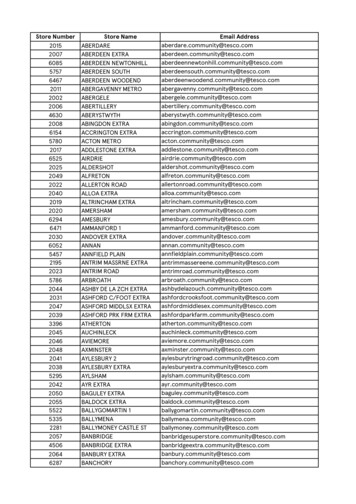

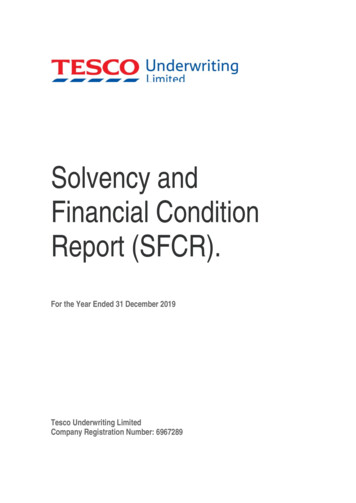
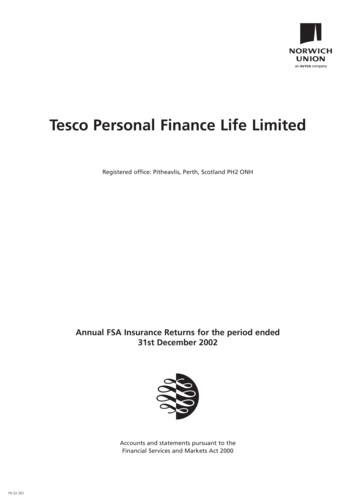


![Welcome [ tescoplc ]](/img/7/ireland-2006.jpg)

